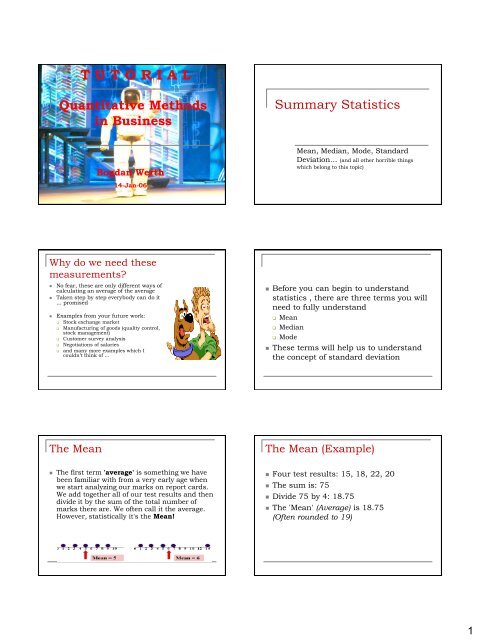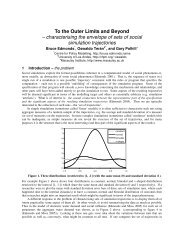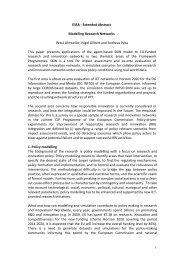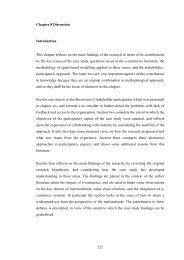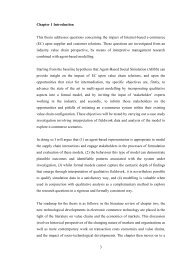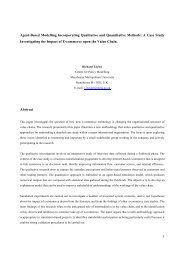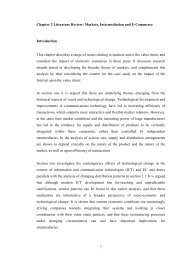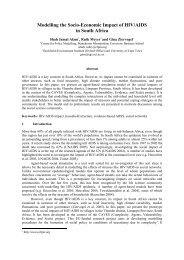IQMB - Mean, median, mode
IQMB - Mean, median, mode
IQMB - Mean, median, mode
You also want an ePaper? Increase the reach of your titles
YUMPU automatically turns print PDFs into web optimized ePapers that Google loves.
T U T O R I A L<br />
Quantitative Methods<br />
in Business<br />
Summary Statistics<br />
Bogdan Werth<br />
14-Jan-06<br />
<strong>Mean</strong>, Median, Mode, Standard<br />
Deviation… (and all other horrible things<br />
which belong to this topic)<br />
Why do we need these<br />
measurements?<br />
• No fear, these are only different ways of<br />
calculating an average of the average<br />
• Taken step by step everybody can do it<br />
... promised<br />
• Examples from your future work:<br />
Stock exchange market<br />
Manufacturing of goods (quality control,<br />
stock management)<br />
Customer survey analysis<br />
Negotiations of salaries<br />
and many more examples which I<br />
couldn’t think of …<br />
• Before you can begin to understand<br />
statistics , there are three terms you will<br />
need to fully understand<br />
<strong>Mean</strong><br />
Median<br />
Mode<br />
• These terms will help us to understand<br />
the concept of standard deviation<br />
The <strong>Mean</strong><br />
The <strong>Mean</strong> (Example)<br />
• The first term 'average' is something we have<br />
been familiar with from a very early age when<br />
we start analyzing our marks on report cards.<br />
We add together all of our test results and then<br />
divide it by the sum of the total number of<br />
marks there are. We often call it the average.<br />
However, statistically it's the <strong>Mean</strong>!<br />
• Four test results: 15, 18, 22, 20<br />
• The sum is: 75<br />
• Divide 75 by 4: 18.75<br />
• The '<strong>Mean</strong>' (Average) is 18.75<br />
(Often rounded to 19)<br />
1
The Median<br />
The Median (Example)<br />
• The Median is the 'middle value' in your list.<br />
When the totals of the list are odd, the <strong>median</strong><br />
is the middle entry in the list after sorting the<br />
list into increasing order. When the totals of<br />
the list are even, the <strong>median</strong> is equal to the<br />
sum of the two middle (after sorting the list<br />
into increasing order) numbers divided by<br />
two. Thus, remember to line up your values,<br />
the middle number is the <strong>median</strong>! Be sure to<br />
remember the odd and even rule.<br />
• Find the Median of: 9, 3, 44, 17, 15<br />
(Odd amount of numbers)<br />
• Line up your numbers: 3, 9, 15, 17, 44 (smallest<br />
to largest)<br />
• The Median is: 15 (The number in the middle)<br />
• Find the Median of: 8, 3, 44, 17, 12, 6<br />
• (Even amount of numbers)<br />
• Line up your numbers: 3, 6, 8, 12, 17, 44<br />
Add the 2 middles numbers and divide by 2<br />
• (8+12) ÷ 2 = 20 ÷ 2 = 10<br />
The Median is 10.<br />
The Mode<br />
The Mode (Example)<br />
• The <strong>mode</strong> in a list of numbers refers to<br />
the list of numbers that occur most<br />
frequently. A trick to remember this one<br />
is to remember that <strong>mode</strong> starts with the<br />
same first two letters that most does.<br />
Most frequently - Mode. You'll never<br />
forget that one!<br />
• Find the <strong>mode</strong> of:<br />
9, 3, 3, 44, 17 , 17, 44, 15, 15, 15, 27, 40, 8,<br />
• Put the numbers is order for ease:<br />
3, 3, 8, 9, 15, 15, 15, 17, 17, 27, 40, 44, 44,<br />
• The Mode is 15 (15 occurs the most at 3 times)<br />
• It is important to note that there can be more<br />
than one <strong>mode</strong> and if no number occurs more<br />
than once in the set, then there is no <strong>mode</strong> for<br />
that set of numbers.<br />
Average/<strong>Mean</strong> has a Problem<br />
though<br />
... which is that if there are<br />
some exceptionally small or<br />
large values in our data set,<br />
they can have an undue<br />
influence on the values in the<br />
middle of our data set.<br />
Stock market Example<br />
Value Telecom SAP<br />
1 92 56<br />
2 50 42<br />
3 49 51<br />
4 44 50<br />
5 48 54<br />
Average 56.6 50.6<br />
outlier<br />
A major disadvantage of the mean is that it<br />
is sensitive to outlying points<br />
Scale like<br />
Just imagine my<br />
husband will buy his<br />
shares only because he<br />
calculated an<br />
average!!!<br />
Helping hand<br />
comes from<br />
Standard<br />
deviation<br />
standard deviation tells us instantly<br />
whether we are dealing with data like<br />
set 1 or set 2.<br />
Here is the prove - the standard<br />
deviation for Telecom stock is 19.92,<br />
for SAP stock it is 5.37;<br />
2
Example (Booklet p.39)<br />
Example (Booklet p.40)<br />
Example (Booklet p.43)<br />
Example (Booklet p.45)<br />
Remember + = 0<br />
Example (Booklet p.47)<br />
3


